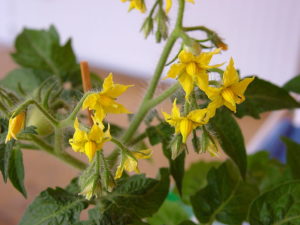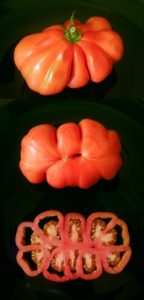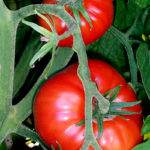![Flagstaff photos: Photo credit: flagstaffotos.com.au Canon 20D + Sigma 150mm f/2.8 (Own work) [GFDL 1.2 (http://www.gnu.org/licenses/old-licenses/fdl-1.2.html)], via Wikimedia Commons](https://www.reddinggardener.com/wp-content/uploads/2017/05/Bright_red_tomato_and_cross_section02.jpg)
You say tomato and I say tomahto…
![nightshade credit: By D. Gordon E. Robertson (Own work) [CC BY-SA 3.0 (http://creativecommons.org/licenses/by-sa/3.0) or GFDL (http://www.gnu.org/copyleft/fdl.html)], via Wikimedia Commons](https://www.reddinggardener.com/wp-content/uploads/2017/05/Bitterweet_Nightshade_2.jpg)
Bitterweet Nightshade blossoms. Europeans were slow to accept the tomato as edible. They confused it with the poisonous nightshades.
It would take a concerted effort by founding father and farmer, Thomas Jefferson, to convince the American colonists that when it came to the tomato there was nothing to fear. Thanks to him, not only do we have Life, Liberty and the Pursuit of Happiness, but also ketchup and spaghetti sauce.
No matter how you pronounce the word tomato, I think we all can agree it’s one of the best vegetables in the grocery store isle. But technically, tomatoes are not vegetables. The term “vegetable” refers to plants with edible leaves, stalks, or roots. Any middle school science student will tell you that tomatoes are a “fruit” as they bear the seeds of the tomato plant. But try telling that to the US Supreme Court.

Edward L. Hedden, Port Collector of New York, sued by tomato farmers for not imposing tariff on foreign tomato imports. Source: U.S. GenWeb
In the 1893 landmark case Nix v. Hedden, the Supreme Court weighed in on the critical issue of whether a tomato is a fruit or vegetable. The Tariff Act of 1883 required a tax to be paid on imported vegetables but not fruit. John Nix, a New York City produce seller, argued that tomatoes were a fruit and were therefore not subject to the tax on vegetables. The Court heard the evidence, including the definition of “fruit” from Webster’s Dictionary. Proving that Justice is not only blind but sometimes deaf and dumb, the Supreme Court ruled that a tomato is a vegetable. After all, logic and science don’t stand a chance when they get between the government and an opportunity to tax.
Despite this botanical ambiguity, tomatoes are among the most popular plants in the backyard garden. All they really need is well drained, nutrient rich soil and sun, plenty of sun. As some varieties get a bit top heavy, you may need to tie the plant to a stake or trellis. Pruning some of the lower, non flowering branch can allow more energy to be sent to the fruit, making larger and tastier tomatoes. Pests that may attack your tomatoes include aphids, cutworms and deer. Occasionally, during a wet season, tomato blight can be a disease problem. Tomatoes grown in full sun are less susceptible to this fungus disease. Tomatoes come in a wide variety, from heirloom breeds to reliable hybrids. You can grow large beefsteaks or sweet cherry tomatoes in red or yellow or even purple.
So now you know how to correctly pronounce tomato and whether it is a fruit or vegetable. Actually… to be completely honest, tomatoes are not vegetable nor “fruit”. Botanically speaking, a fruit is a seed-bearing structure that develops from the ovary of a flowering plant. Because a tomato, unlike an apple or pear, is a “fleshy fruit produced from a single ovary” it is technically a BERRY!
Let’s call the whole thing off…

![By An-d (Own work) [CC BY-SA 3.0 (http://creativecommons.org/licenses/by-sa/3.0)], via Wikimedia Commons](https://www.reddinggardener.com/wp-content/uploads/2017/05/Zebrée_Marron.jpg)



Recent Comments